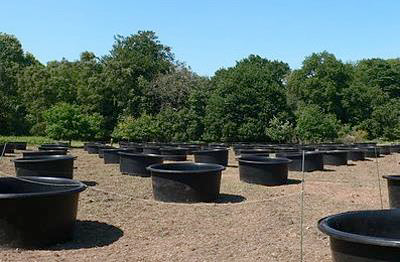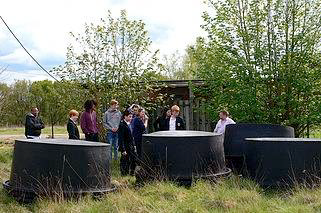Facilities
Transnational Access
Metadata & Data
Papers & Reports
Knowledge Base
Silwood Mesocosm Facility (SMF)
Imperial College London
Infrastructure Description
The Silwood Mesocosms are 96 freshwater ponds, each 0.70 m deep and 1.85 m in diameter, identical to the mesocosms of the Iberian Pond Network (see above). The Silwood ponds were first filled with degassed tap water in summer 2015. Sand and gravel was added to 5 cm depth in October 2015. After this initial establishment phase, the ponds were seeded with organisms and propagules collected from local surface waters to establish standardised communities before starting experiments. The ponds are wide and shallow enough to mix naturally. Instrumentation will be installed in late 2016 in all experimental units to facilitate long-term high-frequency monitoring of temperature and oxygen. Less frequent monitoring of chlorophyll concentrations will be manual. Samples for eDNA and traditional analyses of benthic and planktonic organisms will be taken at the same time. Funding for these activities is secured through a NERC Large Grant (2015-2019), which will address impacts of warming and nutrients on community structure and ecosystem functioning in freshwater food webs. Experimental treatments in the mesocosms, which are part of this project, will be applied from late 2016 onwards. The mesocosm facility is complemented by a variety of facilities, including a microscopy lab, culture/live laboratory, constant temperature rooms (new rooms currently under construction and due for commission in 2017), several general-purpose labs and a -80°C freezer.


Silwood Mesocosm Facility established in 2015 and consisting of 96 ponds and associated research facilities on the Silwood Park Campus near London, UK. Photos: G. Woodward.
Facility Description
96 freshwater mesocosms, 32 more coming in 2017
Organisation Address
Silwood Park Campus
Imperial College London
Ascot
United Kingdom
Infrastructure Address
Silwood Park Campus
Imperial College London
Ascot
United Kingdom
Information Sources
Location
Gallery
Contacts
Prof. Guy Woodward
Dr. Michelle Jackson
Dr. Emma Ransome
Controlled Parameters
Temperature, drought
Research Topics
Climate change, Food webs, Biochemistry, Microbial Ecology
Experiment Years
Started 2016
TA Support
Services currently offered by the infrastructure: Users are given access to the mesocosms and associated laboratories and equipment. Visiting scientists are encouraged to cooperate with local scientists and integrate their research activities with ongoing mesocosm experiments to take full advantage of synergies and local expertise. The current priority for using the Silwood Mesocosm Facility are experiments underpinning the NERC Large Grant described above, which will form the basis for developing additional experiments on site and co-ordinated experiments with sister set-ups elsewhere.
Support offered under AQUACOSM: Imperial College offers open access to all infrastructures at Silwood Park for accepted visiting scientists. However, scientific cooperation with Silwood scientists facilitates using the facilities and instruments and receiving advice from experienced local staff. During mesocosm experiments one person at the SMF is dedicated to ensuring smooth operation of the mesocosms. This includes a try-out of operational procedures, surveillance and maintenance of the facility before starting and during an experiment. One scientist will be available for issues relating to the scientific and practical coordination of experiments, and one or more persons will be responsible for conducting chemical and biological analyses of samples, the results of which may be purchased for a particular project.
TA Modality of Access
At least 234 person-days in total will be allocated to external users supported by an AQUACOSM TA activity in years 2-4. A minimum of 4 visiting scientists over 26 days per year are welcome to join ongoing experiments. Recently started long-term studies using the mesocosm facility focus on the impacts of warming and nutrients on aquatic community structure and ecosystem functioning.
TA Accommodation
Accommodation is on site in private rooms with shared kitchen facilities. Silwood Park is close to Sunningdale which has shops and rail station with direct links to central London.

